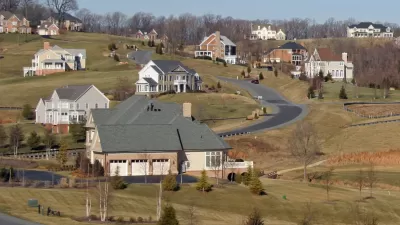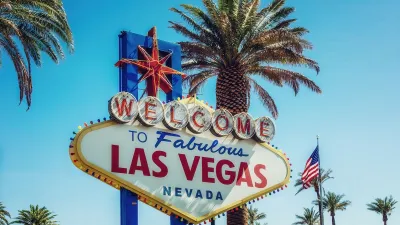Is a new luxury 6,721 square-foot home located in a gated community on the far outskirts of Las Vegas truly “the new face of efficiency"? Kaid Benfield elaborates on how the LEED certification system can be so easily gamed.
The new LEED-Platinum state-of-the-art home built by Blue Heron Homes in Henderson, Nevada occupies twice as much land, and is three times the size, of the average new-home in a US metro area. Not only that, but it is 1.2 miles to the nearest transit stop, and scores a meager 38 out of 100 for walkability. And yet, it has earned the the highest level of LEED certification. Despite acknowledging the beauty and wonder of its architectural elements including "extensive 'water features'” and "17,261 square feet of 'outdoor living space'", Benfield points out that something is not quite right with this picture.
He explains that "[t]he Seven Hills development [where the so-called "New American Home” is located] wouldn’t come close to qualifying for a certification under LEED for Neighborhood Development, which takes location and neighborhood design into account as well as building technology." And, though he commends LEED for “put[ting] green buildings on the map and institutionaliz[ing] building performance measures shown to reduce resource consumption and pollution” he also critiques the many “warts in this system” -- from “being insufficiently demanding of its applicants” to “becom[ing] pro forma, more about earning points than achieving actual environmental performance.”
He concludes, "Why should a building qualify for the highest, platinum rating – signifying the greenest of all green buildings – if it is completely dependent on long automobile trips that will collectively emit more carbon than the building’s efficient heating and cooling systems will save? Maybe ten years ago, the green building movement was so new that it would have been counterproductive to have high standards. But we should be better than that now."
FULL STORY: As good and important as it is, LEED can be so embarrassing

Alabama: Trump Terminates Settlements for Black Communities Harmed By Raw Sewage
Trump deemed the landmark civil rights agreement “illegal DEI and environmental justice policy.”

Study: Maui’s Plan to Convert Vacation Rentals to Long-Term Housing Could Cause Nearly $1 Billion Economic Loss
The plan would reduce visitor accommodation by 25% resulting in 1,900 jobs lost.

Why Should We Subsidize Public Transportation?
Many public transit agencies face financial stress due to rising costs, declining fare revenue, and declining subsidies. Transit advocates must provide a strong business case for increasing public transit funding.

Paris Bike Boom Leads to Steep Drop in Air Pollution
The French city’s air quality has improved dramatically in the past 20 years, coinciding with a growth in cycling.

Why Housing Costs More to Build in California Than in Texas
Hard costs like labor and materials combined with ‘soft’ costs such as permitting make building in the San Francisco Bay Area almost three times as costly as in Texas cities.

San Diego County Sees a Rise in Urban Coyotes
San Diego County experiences a rise in urban coyotes, as sightings become prevalent throughout its urban neighbourhoods and surrounding areas.
Urban Design for Planners 1: Software Tools
This six-course series explores essential urban design concepts using open source software and equips planners with the tools they need to participate fully in the urban design process.
Planning for Universal Design
Learn the tools for implementing Universal Design in planning regulations.
Smith Gee Studio
Alamo Area Metropolitan Planning Organization
City of Santa Clarita
Institute for Housing and Urban Development Studies (IHS)
City of Grandview
Harvard GSD Executive Education
Toledo-Lucas County Plan Commissions
Salt Lake City
NYU Wagner Graduate School of Public Service




























